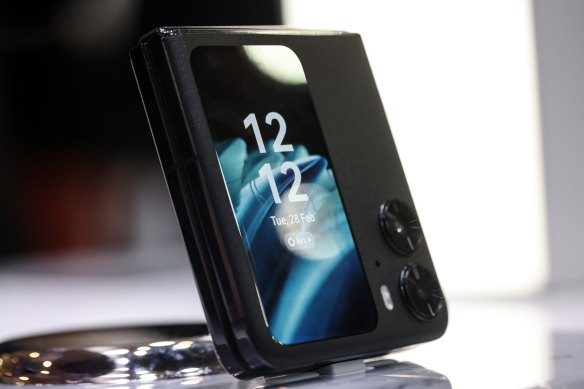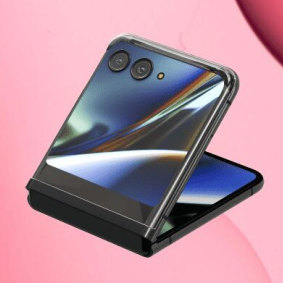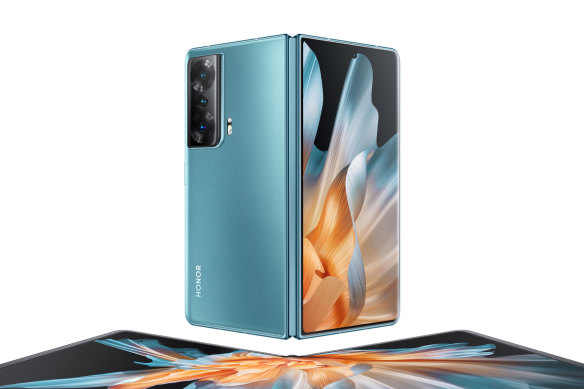
Samsung’s hold on the burgeoning foldable smartphone segment may be at risk of slipping as Chinese brands have set their sights on international markets.
While the Galaxy Z Fold and Z Flip are virtually the only folding phones currently available in Australia, there are many alternatives and imitators sold in China. And this week, the likes of Oppo, Honor, OnePlus and Lenovo brought their own flexible display devices to the Mobile World Congress (MWC) tech show in Barcelona, foreshadowing a flood of new releases in the West.
Oppo’s Find N2 Flip, which is already out in some markets and will launch in Australia on March 16, has an extremely similar look to the Galaxy Z Flip4, but attempts to outdo Samsung in some key specs.
The screen on the front is much bigger at 8.28 centimetres versus the Flip4’s 4.82 centimetres, promising enough room to display six notifications, reply to messages, preview camera shots or show custom widgets without opening the phone.
Meanwhile, the internal screen is slightly bigger and matches the Samsung for resolution, brightness and refresh speed. It also has a much larger battery and charges faster, although it lacks wireless charging.
It can’t quite beat Samsung on price though, since the Flip4 recently had a price drop. It used to start at $1500 – which is what Oppo will charge for the N2 Flip in Australia – but Samsung’s phone now starts at $1200.
The Oppo Find N2 Flip, on show at MWC this week, will soon arrive in Australia.Credit:Bloomberg
The Motorola Razr, another folding phone in the same clamshell format, was released in 2019 but widely criticised for its design and performance. A redesigned and far more expensive version was produced in 2022, but only sold in China and some parts of Europe.
Lenovo — which makes the Motorola-branded phones — confirmed at MWC that it would release a third folding phone this year, and renders from reliable phone leaker Evan Blass show an external screen even larger than the Find N2 Flip’s.
Samsung typically reveals new folding phones around August, and will likely be outfitting its Flip5 with fancy new gear in the face of all the new competition.
A render of a possible Motorola Razr 2023 by Evan Blass.Credit:@evleaks
As for Samsung’s larger book-like Galaxy Z Fold4, it’s been more or less cloned by Honor with its Magic Vs, a foldable with slightly larger internal and cover screens, a bigger battery (again with no wireless), similar cameras and the same Qualcomm chipset.
It was released in China in December, but at the Barcelona tech fair Honor said it planned an international release this year.
No Australian date or price was given, but it will start in Europe at €1600 ($2516) for a device with 512GB of storage. The equivalent Fold4 costs €2012 in Europe and $2700 in Australia.
Notably, none of the Chinese phones appear to be certified resistant to dust or water, which the Samsung phones are. On the other hand, Oppo and Honor claim to have tested their screens to withstand more than 40,000 folds, which is twice the number Samsung quotes.
Samsung has had some modest success with its Z Fold since the original model’s problematic launch in 2019, but the flip-phone-like Z Flip has proven much more popular. In 2020, the company only sold around 3 million foldable phones. But in 2021, the first full year the Flip was available, that figure jumped to around 10 million, 7 million of which were Flips.
The Honor Magic Vs will be sold outside China later this year.
Market research firm Counterpoint estimates around 15 million foldables were sold in 2022, the large majority of them Samsungs. Counterpoint expects the segment overall to grow 52 per cent year-on-year in 2023 to 22.7 million, which is a tiny fraction of overall smartphone sales but around a fifth of all premium high-end sales.
While Google has been long rumoured to be developing a folding phone, most new models appearing this year will be from China.
OnePlus, which is owned by Oppo, promised at MWC to release a foldable phone in the second half of 2023, although it didn’t give any further details.
And Lenovo showed off a prototype “rollable” phone that goes from small and square to tall and rectangular thanks to its coiled screen. Lenovo is also planning to use rolling screens for its ThinkBook laptops.
Get news and reviews on technology, gadgets and gaming in our Technology newsletter every Friday. Sign up here.
Most Viewed in Technology
From our partners
Source: Read Full Article


